Cats are experts when it comes to devoting more than 2/3rds of their day to sleeping. But have you ever noticed that during sleep, cats will often twitch?
There are two basic sleep cycles, active or rapid eye movement (REM) sleep and non-rapid eye movement sleep, which has three stages.
- N1: This stage occurs right after the cat falls asleep and involves light sleep.
- N2: During the next stage, the muscles relax and the brain activity slows.
- N3: The third stage is deep sleep, at which point it may be hard to wake the cat.
REM sleep
The purpose of REM sleep is still not entirely understood, but it is thought to stimulate areas of the brain that are essential to learning and exercising important neural connections. Active (REM) sleep produces rapid movement of the eyes and the characteristic twitching of the limbs, toes, ears, whiskers, and eyes (hence the name rapid eye movement). During REM sleep, the brain is almost as active as when the cat is awake, heart rate and blood pressure are increased. Cats spend approximately 24% of their sleep cycle in active sleep.
One study found that rats who were repeatedly deprived of REM sleep had a considerably shortened lifespan from 2-3 years to five weeks.
Video courtesy meow meowhugo, Youtube
Non-REM sleep
Non-REM (deep sleep) sleep occurs the remainder of the time. During this phase, the cat’s body repairs and regenerates itself, rebuilding muscles, bones, the immune cells. Aside from the gentle rise and fall of the chest, there is no movement during non-REM sleep.
What is the purpose of twitching?
It is often suggested that twitches are a by-product of dreams…the cat may be dreaming of chasing a mouse, which causes the limbs to move. This is not the case, studies have found that twitching starts in the late fetal period in rats and the highest frequency of twitching occurs in the first two weeks of the rat’s life which coincides with the period of rapid growth and the emergence of motor skills. Twitching continues into adulthood but at a reduced frequency.
The purpose of twitches is to instruct the brain about the developing body. The muscles are atonic (relaxed) and twitch in an organised pattern. Twitches activate the neural networks throughout the central nervous system in the developing brain.
Do cats dream?
Dreaming occurs in people during REM sleep, but we still don’t know if cats dream during sleep but it is likely that they do. What cats dream about, we will never know, and they’re not telling us. Dreaming in humans is thought to process the events we have experienced and consolidate memories.
Twitching during wakefulness
Twitching can also occur when the cat is awake which can be potentially serious. Causes include hypocalcemia (low blood calcium), feline hyperesthesia, chronic kidney disease, seizures and poisoning (especially pyrethrin which is a common ingredient in dog flea treatments).

